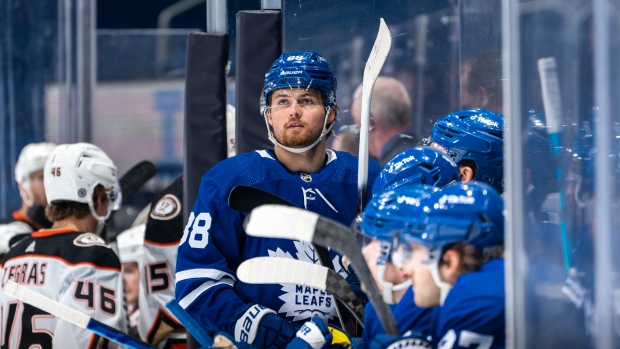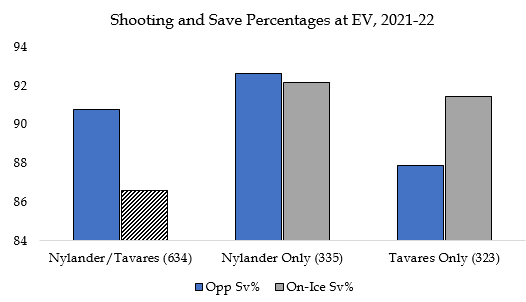Mar 28, 2022
Is Keefe’s criticism of Nylander warranted?
Sheldon Keefe was blunt in Saturday’s post-game assessment of William Nylander’s game of-late. Is it deserved compared to, say, the Leafs’ goaltending?
By Travis Yost

Perhaps William Nylander would have momentarily escaped his coach’s ire if the Toronto Maple Leafs were able to take care of business against the bottom-feeding Montreal Canadiens on Saturday night.
But they did not. And a clearly frustrated Sheldon Keefe was blunt in his post-game assessment of William Nylander’s game of-late. His brief assessment: not good enough.
Toronto has found itself in a precarious position of late – the team is still playing well and a playoff berth is all guaranteed, but cracks are starting to form. As other Eastern Conference contenders start to elevate their play, Toronto’s headed in the opposite direction, and much of it has to do with ugly goaltending from the likes of Jack Campbell and Petr Mrazek. (Erik Kallgren, to his credit, has been solid in spot duty.)
Nylander being the player to draw criticism here is interesting. Forwards can go through myriad slumps over the course of the season, but some of those slumps are more concerning than others. A player whose scoring production has dipped in parallel with less offensive volume is of concern; a player who has seen scoring drop despite generating heaps of scoring chances tend to be guys dealing with a rash of bad luck. These are also the types of players who tend to rebound over time.
Nylander won’t be mistaken for a top-tier scorer, but rather an effective two-way player who can control games at both ends of the ice. This season, Nylander has amassed 59 points (24 goals and 35 assists) in 64 games. Assuming this pace holds, Nylander will break his single-season scoring record (61 points), and he has an outside chance at catching his single-season goal scoring record (31 goals). The offence has been there.
Trended over the course of his career, it’s hard to see where Toronto would be concerned with offensive production. Both even-strength and all situations rate-scoring are in a multi-year uptrend, shots follow a similar pattern, and this season, he’s around 82nd percentile for qualified forwards:

Individual offensive production is just one component to measure, though. Let’s set aside Nylander’s scoring for a moment and look at on-ice results, or how Toronto’s five-man units are performing when Nylander is deployed. When Nylander’s been cooking, you see gains in both areas of the ice: his playmaking benefits linemates in the offensive zone, and his positioning and awareness curtail pressure in the defensive zone. This year, his common linemates have been John Tavares, Alex Kerfoot, Morgan Rielly, and T.J. Brodie.
What are we seeing from Nylander and company lately? Let’s isolate to the last three seasons here and see if we can find anything breaking down:

Now we're getting somewhere. Nylander’s normal dominance on-ice has completely deteriorated since December in a way we haven’t seen in his career. Expected goals are heading in the same direction, but the move has been far more muted. Key takeaway: Toronto’s normal on-ice dominance has moved closer to break-even with Nylander on the ice, but the effects of that move have been exacerbated by something else.
So, why has it been a bloodbath for Toronto (-11 goals) since the start of the calendar year for Nylander? Let’s focus this time on the percentages. Below, the same 3-year plot, but only focusing on on-ice shooting percentages and save percentages:

Toronto’s offensive output has not changed in any meaningful way during this slump. In fact, Toronto’s seen a very predictable 9.5 shooting percentage with Nylander on the ice these last few years, with very little intra-season volatility. The goaltending? A complete and utter collapse, one that started – you guessed it! – around the end of December. This despite no change in expected goal rates faced by Toronto goaltenders with Nylander on the ice.
Lastly, let’s isolate on goaltending performance across a few different lineup iterations. We will focus on Nylander and Tavares, who have played a healthy amount of minutes both together and apart. Pay careful attention to how the save percentages change:

You can only reasonably conclude three things here. Either Nylander and Tavares combine to create some defensive disaster for Toronto goaltenders whenever they are on the ice, or Toronto goaltenders have just been miserable at stopping shots with the second-line deployed. There’s credible evidence the latter is the case: whenever Nylander and Tavares have been split on different lines, save percentages have been robust. And last season? This same Nylander/Tavares combination saw 92.9 per cent stop-rates, well higher than the league average.
No one knows his lineup better than Sheldon Keefe. And certainly watching Maple Leafs games of late, Nylander hasn’t been as electric as he can be. But it’s hard not to look at the data and think Toronto’s porous goaltending has muddied the water, so much so that criticism of the rest of the lineup seems misplaced.
Toronto needs a goaltending solution right now. The rest will solve itself.
Data via Natural Stat Trick, NHL.com, Evolving Hockey

